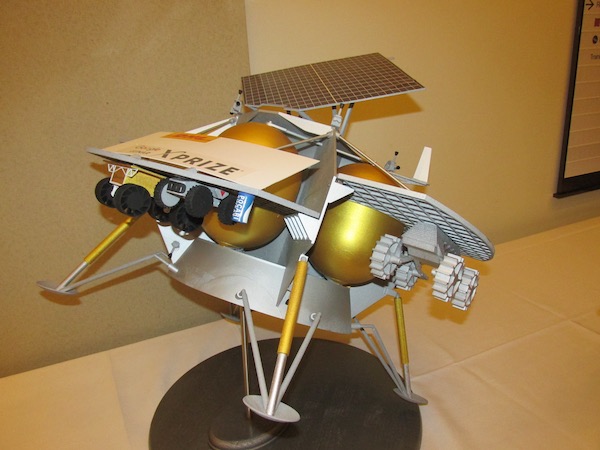Fly me to the Moonby Dwayne Day
|
| Shingles started by saying that “you have to disrupt before you are disrupted,” and then added that you have to “Uber before you are Kodaked.” |
For some reason that scene popped into my head Tuesday evening as I sat in a meeting room in the Library of Congress as Marcus Shingles, the Chief Executive Officer of the XPRIZE Foundation took the stage. The occasion was a presentation of short films about Google Lunar X PRIZE (GLXP) participants, part of a project called Moon Shot and started by J.J. Abrams, who, we were told, loves space (just not Star Trek). Moon Shot is billed as “a space story about life on Earth,” which sounds nice enough, until you start to understand what it actually means.
Shingles started by saying that “you have to disrupt before you are disrupted,” and then added that you have to “Uber before you are Kodaked.” This drew a chuckle from the audience, so he repeated it. Then he showed a graph indicating the increase in computing power over the decades, explaining the power of exponential growth, which is something that Shingles is apparently obsessed with. He wanted us to recognize that this amazing computing accomplishment was not marred by things like the Depression, World War II, or 9/11 (which I’m sure was comforting to the people who were inconvenienced by those events.) Exponential growth is great, Shingles said, and we have to harness its power to other things, like biotech, and spaceflight—as if exponential growth is some kind of physical thing that you spray over other things to cause them to get bigger and better. After all that, Shingles explained to us that the XPRIZE Foundation exists to occupy the space between the things that governments cannot do, and the things that businesses won’t do.
This introductory talk, filled with jargon and motivation, was also rather light on actual information. And the whole time I sat there feeling like he was about to sell us a vacation timeshare and wondering if he had a point.
Shingles was followed by a woman from the Google Lunar XPRIZE, who said that she had first started working for them seven years ago and back then she wondered if there was a way to better communicate to the general public what they were doing. And now, tonight, a short seven years later, they were debuting their new message to a mix of Washington policy wonks, many of whom probably showed up because they heard there was going to be beer.
What followed were a series of short films, each about ten minutes long, devoted to four of the GLXP contestants. They were slick, beautifully filmed and edited, full of stunning landscapes, cute children, and some of the best photography of the Moon in the night sky that you’ve seen on the big screen. The first focused on an Israeli engineer working on his company’s GLXP entry. His grandfather was sent to Auschwitz, he told us, but he ultimately survived because he was transferred to a slave labor camp to build V-1 and V-2 rockets. His wife and young daughter perished. The engineer said that his grandfather taught him to always be optimistic. The engineer was shown talking to schoolkids and visiting the cemetery where his grandfather is buried. The film was moving and heartfelt. It ended with the engineer saying, “I can only hope that the children of this region will build a better future and put the past behind.”
| Helium-3 is like Bigfoot for Moon programs: somebody is always chasing it even though it may not exist (fusion reactors certainly don’t.) |
The next short depicted a man of Indian descent working for an American GLXP participant. He explained how he grew up in crushing poverty in India. His family was always moving, never had a home. But he was encouraged by his mother to work hard and he did, eventually coming to America without any money. He started a technology company in Silicon Valley and made a lot of money. Now he’s working for Moon Express on the GLXP challenge… because he wants to mine helium-3 on the Moon for use in our fusion reactors.
Yeah, at that point in my head I heard the needle scratch off the record. Helium-3 is like Bigfoot for Moon programs: somebody is always chasing it even though it may not exist (fusion reactors certainly don’t.)
The next film featured an American, an engineer for GLXP competitor Astrobotics. He is also a professor and teacher… and a farmer? We saw images of him on his farm walking through Pennsylvania fields, breaking open ears of corn, stepping into his barn. We also heard him talk about working with his former students on robots. He loves robots and believes that every robot has the essence of its creator inside its circuits. He told us that he may be slowing down, but the things he creates and the people he inspires—especially the students—are speeding up. “The human spirit will win,” he told us.
This was followed by another short featuring a young woman in India who confesses that ever since she was a little girl she has been obsessed with math. She always wanted to study math, even when she was one of only three girls in a math class filled with boys. Even when she was kidded by the men in her graduate classes who told her that she should stay home and relax like the other women. She says that she was inspired by astronaut Kalpana Chawla, who was born in India, emigrated to the United States, and died when Columbia broke apart over Texas in 2003. We see the young woman talking to students, trying to inspire young girls to study mathematics. “Follow your dreams,” she says.
So, if you’re taking notes:
Be optimistic.
The human spirit will win.
America is the land of opportunity.
Spaceflight is inspirational, especially for children.
Children are the future.
Follow your dreams.
Also: helium-3.
Except for the last one, those are the kind of vapid platitudinous messages that you see on American Idol. They’re also pretty standard spaceflight justifications, the same ones we have heard for decades.
It’s not that the films were bad or even overly treacly. They weren’t. They were beautifully produced and uplifting, which is exactly what they were supposed to be. If you watch the various short films with subtitles occasionally you will see “[stirring music]” at the bottom of the screen. Actually, not just occasionally, you’ll see this quite a bit. They would probably be effective with a general audience that didn’t know anything at all about the Google Lunar X PRIZE or space or robotics or science. The problem was that they were also entirely free of content: not chicken soup for the soul but cotton candy for the soul, dissolving as soon as they hit your brain. We didn’t learn anything about the individual teams or the competition itself, only an inspiring story about one member of each team, followed by another inspiring story, and another, and another.
| Although we had been sitting there for over 90 minutes, nobody from the XPRIZE Foundation or GLXP or in the videos or on the panel had really bothered to explain exactly what the Google Lunar X PRIZE is, at least in terms of dates, deadlines, and objectives. |
There were supposed to be six films, but a technical glitch led to them showing only four of them (all of them are online), but that was more than sufficient for one sitting: too much cotton candy will make you a bit sick to your stomach. The films were followed by a brief panel discussion featuring members of GLXP competitors Moon Express and Astrobotics, along with a representative from NASA who oversees prize competitions for the agency (although NASA is not involved in GLXP.) In response to a moderator’s question about the biggest challenges, the representative from Moon Express said that they were financing, technology, and regulation, in that order. But he thought his team had the financing part handled fairly well. The panelists talked in general terms about what they were doing, with the representative from Astrobotic mentioning their newly-unveiled Peregrine lunar lander. And then the discussion was over, with everybody eager to head out to the lobby for beers and look at a mockup of the Peregrine lander and its three tiny rovers.
 The audience at the Moon Shot screening at the Library of Congress June 7. (credit: D. Day) |
As the audience was getting up from their seats the moderator hurriedly asked if there were any audience questions and finally somebody stood up and asked, “What is your schedule?”
And that’s when it struck me that although we had been sitting there for over 90 minutes, nobody from the XPRIZE Foundation or GLXP or in the videos or on the panel had really bothered to explain exactly what the Google Lunar X PRIZE is, at least in terms of dates, deadlines, and objectives. The guy from Moon Express explained that the competitors had to launch to the Moon by the end of 2017 and said that his company currently has contracts with Rocket Lab for three launches, two in 2017 and one in 2018. What he did not add is that Rocket Lab has never launched a single rocket, let alone one to the Moon, so how much is that launch commitment actually worth? What he also did not mention—nobody did—is that the original deadline for the Google Lunar XPRIZE project was 2012. There was a fallback deadline of 2014. Of course here we are in 2016 and still nobody has done it. The goalposts have been moved several times, and may be moved again. That fact will be omitted from all press releases.
Throughout this entire event I kept thinking that although Mars has been getting a tremendous amount of attention for the past few years, maybe the Moon is about to make a comeback. A new administration in the White House will undoubtedly ask for a reevaluation of NASA’s plans, and there has been some recent talk about putting a habitation module in cislunar space, if not lunar orbit. Maybe the debate is about to shift and we will start talking about the Moon a lot more.
But the GLXP event was remarkably devoid of substance. It wasn’t until the very end, and then almost accidentally, that anybody bothered to explain what their objective was and why, and even then they couldn’t explain why this was important beyond resorting to platitudes. If the lunnites are going to make any kind of headway against the Mars nuts, they’re going to need to work on their sales pitch. Glossy inspirational videos are not really enough, all surface pretty and content free. Neither is a motivational speech about harnessing the power of exponential growth to send rovers to the Moon to do something that doesn’t really have a very clearly defined need. As I walked out of the building the sun was setting over the Capitol dome, and I wondered how I am going to Uber before I am Kodaked. I know this is somehow important, but what the heck does it mean? And is there anybody who can tell me?
